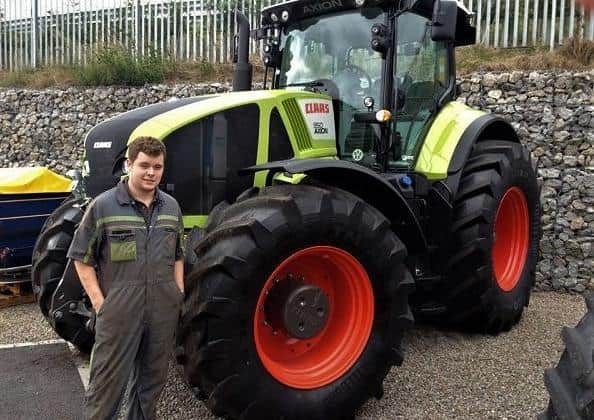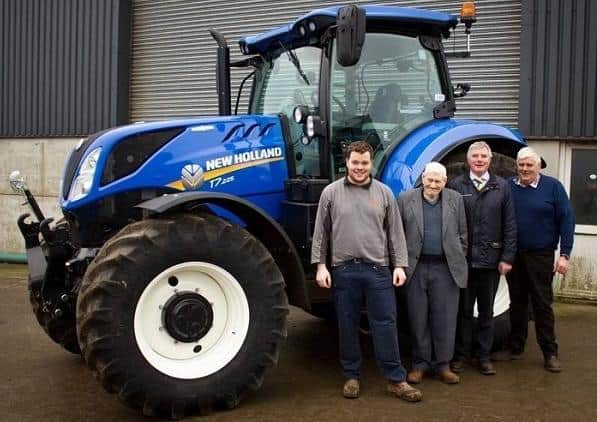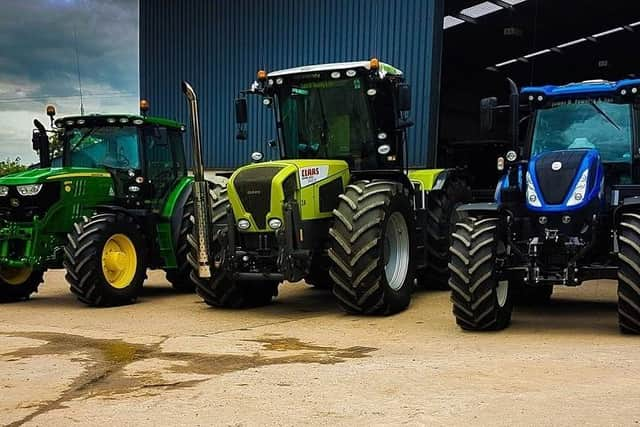Running a modern NI agricultural contract business
and live on Freeview channel 276
It provides regular high output precision contract field services to both livestock and arable commercial farm businesses across a service radius of up to 30 miles from base and employs four full-time staff as well as other regular machine seasonal operators.
Before joining the family business James studied at Harper Adams University, Shropshire and graduated from there, with his Masters degree in Agricultural Engineering, in 2015.
Placement year experience
Advertisement
Advertisement


As well as the normal academic core engineering and management studies taught at Harper Adams the curriculum includes a Placement Year spent working out in the agricultural machinery sector. James spent his year working within the Claas UK dealership network in Yorkshire. This gave him close access to the complete Claas product range, experience as part of a dealership team and direct involvement with field services supporting a wide range of farm customers in the area.
Examples included working as a product sales assistant, preparing and manning sales stands at agricultural shows, assisting with delivery of new combines to customers and working at on-farm demonstration road shows for the Lexion 780 combine, Xerion 5000 and Axion 800 series tractors.
Experience in the Claas used machinery sector showed the qualified economic benefit of planned pre-sale restoration of specific machines. Whilst refurbishment of forage harvester pick-up reels is routine more detailed specific machine technical knowledge, of the condition of more complex internal components, is necessary to decide what work can be justified when costing a used harvester for resale.
Harper Adams student project examples involve students in practical design projects encouraging lateral thinking and trying the application of new technologies. One example involved James and his fellow students setting up a miniature vehicle with robotic control to travel along simulated crop rows. They used their initiative to solve practical operational problems and beat their opposition!
Advertisement
Advertisement


A study, for a 4th year project was comparison of the traction and soil compaction performance during cultivation work using a Claas Xerion 5000 tractor within the tyre manufacturer’s technical guidelines. Two sizes were considered and a related research project within the M Eng course considered the effect of a range of tyre pressures (from 0.6 bar (9 psi) to 1.6 bar (24 psi). Harper Adams has its own soil hall where the effects of compaction and cultivation can be studied indoors. Digital penetrometer readings were used to measure soil compaction and sensors were also buried down in the sub-soil at 400 mm. The results confirmed the benefit of using reduced pressures and how tyre wall flexing gives a longer soil footprint but limits travel speed. Having a tyre pressure control system to select the best pressure for field or road is now a commercial option for some tractors and trailed machinery. The student project went on to measure distortion stress within a tractor tyre. Various sensor locations were tried and an identified accuracy problem shared with the manufacturer for further development.
The main activities during the J D Townley and Son team’s working year are:
Slurry spreading starts in February as soon as the ban is lifted. Townley’s now use an umbilical system, with the slurry pumped out by the high capacity Doda pump through a flexible hose directly to a, NH T7.225 tractor mounted, 12m boom dribble bar working in the field. The system can pump out to two miles and for longer distances slurry is transported out in 3000g tankers to a docking station and pumped on from there. Farmers are always anxious to get their slurry out as soon as possible because delays have a significant knock-on effect for other field operations such as the timing of the 1st grass silage cut. The pressure on contractors to get this work done typically involves 7.00 am to 10 00 pm working days.
Late February/March/April is busy with cereal top dressing and grassland urea spreading using a twin disc Amazon ZA-V spreader. Following on from ploughing, spring barley sowing commences, either using the single-pass power harrow/seed drill combination or the air seeder following power harrow seedbed preparation. Forage maize sowing under plastic film is also under way using the SAMCO 4 row precision drill at the rate of around 20 acres/day. Each plastic roll change can cover five to six acres. It was interesting to hear of the policy of programmed fitting of new blades to reduce power requirement and fuel usage when working with the power harrows. The service life of a set of blades’ is around 300 acres in moist Co Down soils but less in dry stoney conditions. RTK autosteer is routinely used to guide accurate work in the field and especially in poor visibility, darkness or in dust clouds during cultivations.
Advertisement
Advertisement


In favourable conditions the air cereal seed drill can sow 50 to 80 acres/day. The 8-row Gaspardo maize drill, with a work rate of up to 80 acres/day is also used at this time in the coastal sites of the Ards Peninsula where plastic film cover is not normally used. Operationally, Townleys view the complete cost per acre of uncovered maize from seed to clamp as equivalent to that of spring barley and covered maize as similar to winter wheat.
Grass harvesting
May is the start of this busy/large scale grass harvesting operation based around the output of the 775 hp Claas Jaguar 970 forage harvester. Picking up 50’ raked grass rows is preferred for field efficiency achieving fuel usage as low as 4 -5 litres/acre. Where small irregular fields or heavy crops require the use of narrower row spacing 6-8 litres/acre is typical. Some adjustment of the normal contract charge can be made around these factors. The capital cost of new high capacity machines like SPFHs has been increasing and careful evaluation of when to replace, or upgrade, it is now a vital annual management decision in minimising operational costs. The importance of this harvester’s role in the business workload is evident from the fact that it uses around 50% of all the fuel in the entire fleet!
For grass mowing Townleys have been using the same 300hp Claas Xerion 3300 tractor since 2008. It has 4 wheel co-ordinated steering, continuously variable transmission and travels on the road with the three mowers folded on the rear linkage. In the field, it works in reverse-drive mode when the entire cab has been power-rotated through 180 degrees. This gives the driver a comfortable elevated clear view over all three mowers in work. Keeping the same tractor and changing the mowers every five to six years has proved preferable to the other available alternatives.
A JCB 435S loader, with a 14’ folding fork, is used for clamp filling and consolidation.
Advertisement
Advertisement
The Claas Jaguar 970 is also used, during June/July with a 5.2m disco direct cut header for whole crop harvesting. Its work rate, often around 20 -30 acres/day (compared to 70-200 acres for grass) may seem disappointing but is largely due to the header having to be taken on and off between individual fields and for transport. Fuel usage on this work is around 10 litres per acre.
The Jaguar 970 is also used for forage maize harvesting during mid/late October. Ground conditions then can be challenging so the trailers are fitted with pusher bars in case they need additional help to keep them moving.
Grain harvesting and drying
Townleys operate two high capacity combines (including a 25’ cut rotary Claas Lexion 750 and a 22’ cut New Holland CX8.80 6-walker combine). Both run on rubber tracks which provide good flotation and grip in the field, minimise transport width and can travel smoothly at 40kph on the road between farms. They also operate a 20’ cut Claas Lexion Montana 630 hillside combine which, by self levelling, can maintain threshing efficiently on land with up to 17 degree slopes. As such it is well suited to serving the needs of cereal customers who farm the drumlin hill land in the Downpatrick area.
Two CASE high density 8’x 4’x3’ square balers are used for straw and they have the option of acid application. Round baling is also provided but, due to the ready availability of used balers, there is a trend for some farmers to bale their own, Autumn cultivations then take place for winter cereal sowing using a pair of 3 metre one pass power harrow drill combinations.
Advertisement
Advertisement
Land drainage, digger work and hedge cutting maintenance services are also provided.
Grain drying
It was decided two years ago to move away from reliance on mobile driers and invest in a fixed installation automatic gas-fired continuous flow version. A Svegma 15 tph continuous flow drier has been installed and is powered through a 3-phase electricity generator. It is anticipated that the increased throughput, service life and automated features will be a more efficient long-term solution for the intense needs of the combined farm and contract business requirements compared to the previous reliance on tractor-powered mobile driers.
Overall financial management
Good record keeping, machinery performance monitoring and management of assets has obvious priority in the business. Invoices for field work are issued to customers routinely throughout the year after work is completed. James admits that his Mum has a key role in this process.
December to January is the time for administration paper work such as farm quality assurance documentation and other financial management. Insurance cover costs for agricultural contract work always stand out as much higher compared to those for a farmer doing his own field work.
Machinery maintenance
Advertisement
Advertisement
Townleys run their own workshop for routine servicing, maintenance and repairs. They prefer to stick with 500 hour service intervals with tractor servicing costs at around 80-90 pence/hour. Machine operators assist with this work and back-up is available from the main dealerships, all three of which are less than 20 miles away.
A discussion period followed this impressive account of combined practical and academic skill/knowledge after which I Agr E Branch Chairman Ken Gardner thanked James for preparing and delivering his excellent presentation and wished him and the business every success for the future.